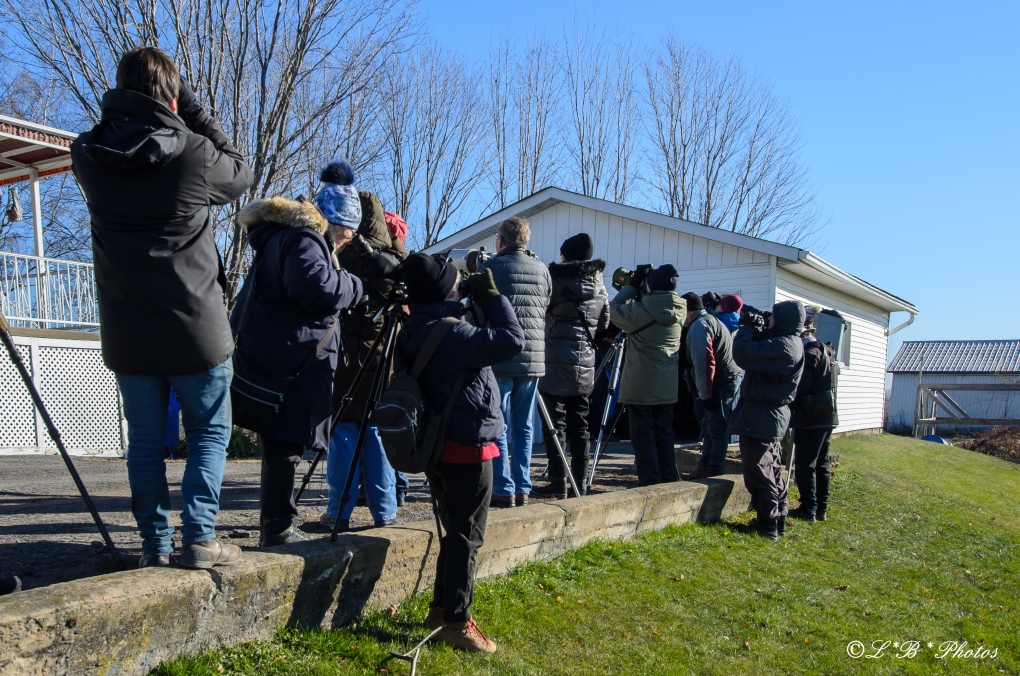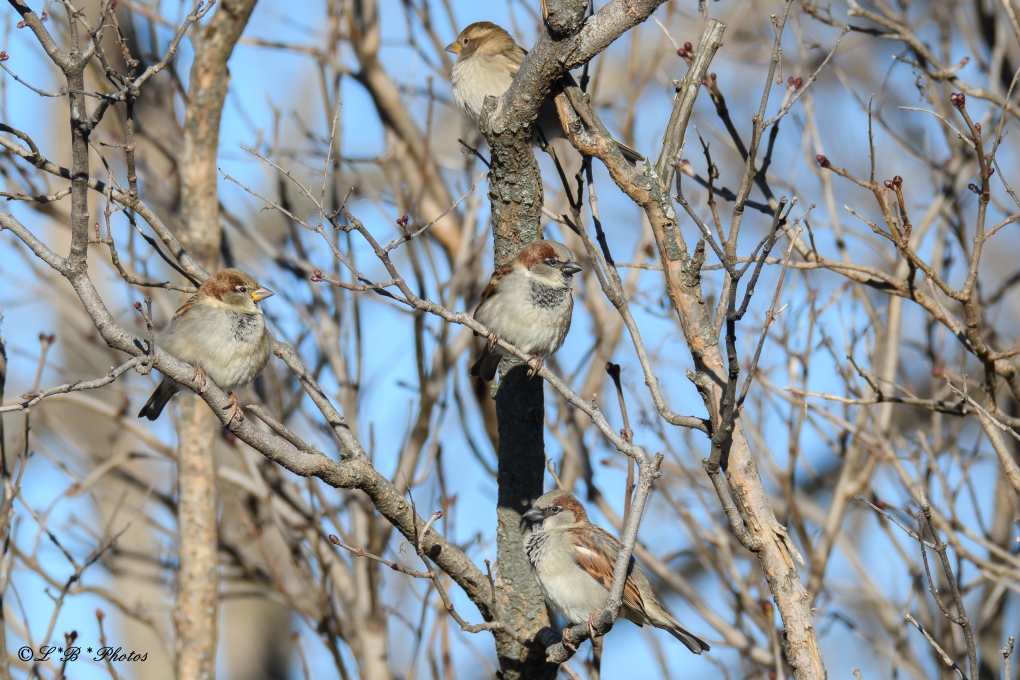'It's quite amazing': Eurasian tree sparrow draws crowds to small Quebec town far away from its natural habitat
People walking by might not even notice Quebec’s newest feathered visitor.
It’s not as agile as Montreal’s swift scissor-tailed flycatcher, as colourful as Laval’s magnificent mandarin duck, or nearly as stoic as Granby’s flamboyant flamingo. If you see it, you might even think you’ve seen it before.
It takes a trained eye to spot the Eurasian tree sparrow, which has taken the spotlight among Quebec’s birding community in recent days after finding itself across an ocean from its natural habitat.
Birders have raced to its new digs in a residential backyard in Saint-Barthélemy, in Quebec's Lanaudière region, to catch a glimpse of the bird -- which looks quite similar to a common house sparrow.
“It is hard to tell at first,” said Montreal bird watcher and photographer Lori Bellerdine. “But after a while, you get to recognize his black markings on his cheeks, so it’s quite amazing.”
The black, brown, and white bird is small enough to fit in the palm of your hand. Its wingspan can stretch to about 20 centimetres, or for non-ornithologists, about the length of a banana.
Bellerdine said she first got word about the sparrow’s arrival from an online forum. She had already been out on a mission to snap pictures of snowy owls, but took a detour after she saw a group of photographers crowded near a neighbourhood home.
When she joined them, she said it was tough to get a good look at the bird, which was hidden among the bushes near an exceptionally welcoming family’s home. She was offered coffee.
“We all got to enjoy it together,” said Bellerdine, speaking of the gaggle of photographers.
“I'm not sure why he's here,” speaking of the bird. “But he’s very popular.”
 A crowd gathered to snap a picture of the Eurasian tree sparrow which was spotted in Saint-Barthélemy, Que. (Photo courtesy of Lori Bellerdine)
A crowd gathered to snap a picture of the Eurasian tree sparrow which was spotted in Saint-Barthélemy, Que. (Photo courtesy of Lori Bellerdine)
A crowd of bird watchers gathers to snap a picture of the Eurasian tree sparrow, which was spotted in Saint-Barthélemy, Que. (Photo courtesy of Lori Bellerdine)
A LONG WAY FROM HOME
Unsurprisingly, Eurasian tree sparrows are native to Eurasia, and they're quite common across the region.
While it’s possible this one caught an air current from Europe and flew across the Atlantic, or escaped from someone’s private bird collection, it could’ve also arrived from a smaller colony near St. Louis, Mo.
That particular group first arrived in the U.S. in late April of 1870. A flock of 12 Eurasian tree sparrows were shipped from Germany in order to provide a familiar bird species to newly-landed immigrants.
From there, the birds expanded to northeastern Missouri, west-central Illinois, and southeastern Iowa.
While the species covers a lot of territory around the world, it’s unusual to find them in new places.
“This is a species which is very sedentary, they don't move very much. They're not migratory,” said Kyle Elliott, a McGill University ornithologist. “It’s a really rare sighting.”
Eurasian tree sparrows don’t like cities, unlike their house sparrow cousins, and they usually stick together in groups.
Elliot says this one is probably a vagrant — an outlaw — which is a seriously lonely existence for a sparrow.
“In most cases, vagrants don’t last very long, so it’ll likely move on somewhere else and keep searching to find other members of its flock.”
“It must be a stressful event to be so far away and wondering where its mates are,” said Elliott. “Just going to sleep every night by itself must be a lonely event. Especially on a colder Montreal night.”
Even if the bird doesn’t find its way home, there is still hope, Elliott said.
Since Eurasian sparrows are so closely related to house sparrows, it’s possible it could find a new flock here, in its new home; not exactly like living with brothers and sisters, but family, nonetheless.
Bellerdine said she’s seen it hopping around the same area when she returned over several days to snap more pictures.
It was spending time with other sparrows, she said, and they seemed to be getting along just fine.
 A small group of sparrows is seen sitting in a tree in Saint-Barthélemy, Que. (Photo courtesy of Lori Bellerdine)
A small group of sparrows is seen sitting in a tree in Saint-Barthélemy, Que. (Photo courtesy of Lori Bellerdine)
A small group of sparrows is seen sitting in a tree in Saint-Barthélemy, Que. (Photo courtesy of Lori Bellerdine)
WHAT’S WITH ALL THESE BIRDS?
Quebec has had its fair share of rare bird sightings in recent months, with the scissor-tailed flycatcher making national headlines after it was spotted near the Dorval Technoparc in November.
Bellerdine said all these birds are keeping her busy.
“There are so many rare birds coming our way,” she said, adding that she’s never seen so many far-away birds arrive “at this frequency.”
Elliott said there are a couple of ways to explain the phenomenon.
First, “birding as a pastime has just exploded during the pandemic,” he said.
“We can't do anything else. We can't go travel, we can't interact with other people, but we can go out and look for birds,” he said. “There have been a ton of people out searching for birds, and so they’re more likely to encounter a vagrant,” like the sparrow in Saint-Barthélemy.
Another reason, unfortunately, is climate change, according to Elliot.
“We hear an awful lot about how the world is changing at the moment,” he said. There have been “floods and fires out west … and then in northern Quebec this year, [we’ve had] record breaking temperatures.”
“With all these changes, it's not surprising that some of these birds are getting a little bit disoriented,” he said.
“They really rely on air currents to be able to migrate and move around. Without those air currents, they're going to have trouble trying to figure out where to go.”
CTVNews.ca Top Stories

Quebec nurse had to clean up after husband's death in Montreal hospital
On a night she should have been mourning, a nurse from Quebec's Laurentians region says she was forced to clean up her husband after he died at a hospital in Montreal.
Northern Ont. lawyer who abandoned clients in child protection cases disbarred
A North Bay, Ont., lawyer who abandoned 15 clients – many of them child protection cases – has lost his licence to practise law.
Bank of Canada officials split on when to start cutting interest rates
Members of the Bank of Canada's governing council were split on how long the central bank should wait before it starts cutting interest rates when they met earlier this month.
Maple Leafs fall to Bruins in Game 3, trail series 2-1
Brad Marchand scored twice, including the winner in the third period, and added an assist as the Boston Bruins downed the Toronto Maple Leafs 4-2 to take a 2-1 lead in their first-round playoff series Wednesday
Cuban government apologizes to Montreal-area family after delivering wrong body
Cuba's foreign affairs minister has apologized to a Montreal-area family after they were sent the wrong body following the death of a loved one.
'It was instant karma': Viral video captures failed theft attempt in Nanaimo, B.C.
Mounties in Nanaimo, B.C., say two late-night revellers are lucky their allegedly drunken antics weren't reported to police after security cameras captured the men trying to steal a heavy sign from a downtown business.
What is changing about Canada's capital gains tax and how does it impact me?
The federal government's proposed change to capital gains taxation is expected to increase taxes on investments and mainly affect wealthy Canadians and businesses. Here's what you need to know about the move.
New Indigenous loan guarantee program a 'really big deal,' Freeland says at Toronto conference
Canada's Deputy Prime Minister Chrystia Freeland was among the 1,700 delegates attending the two-day First Nations Major Projects Coalition (FNMPC) conference that concluded Tuesday in Toronto.
'Life was not fair to him': Daughter of N.B. man exonerated of murder remembers him as a kind soul
The daughter of a New Brunswick man recently exonerated from murder, is remembering her father as somebody who, despite a wrongful conviction, never became bitter or angry.
































